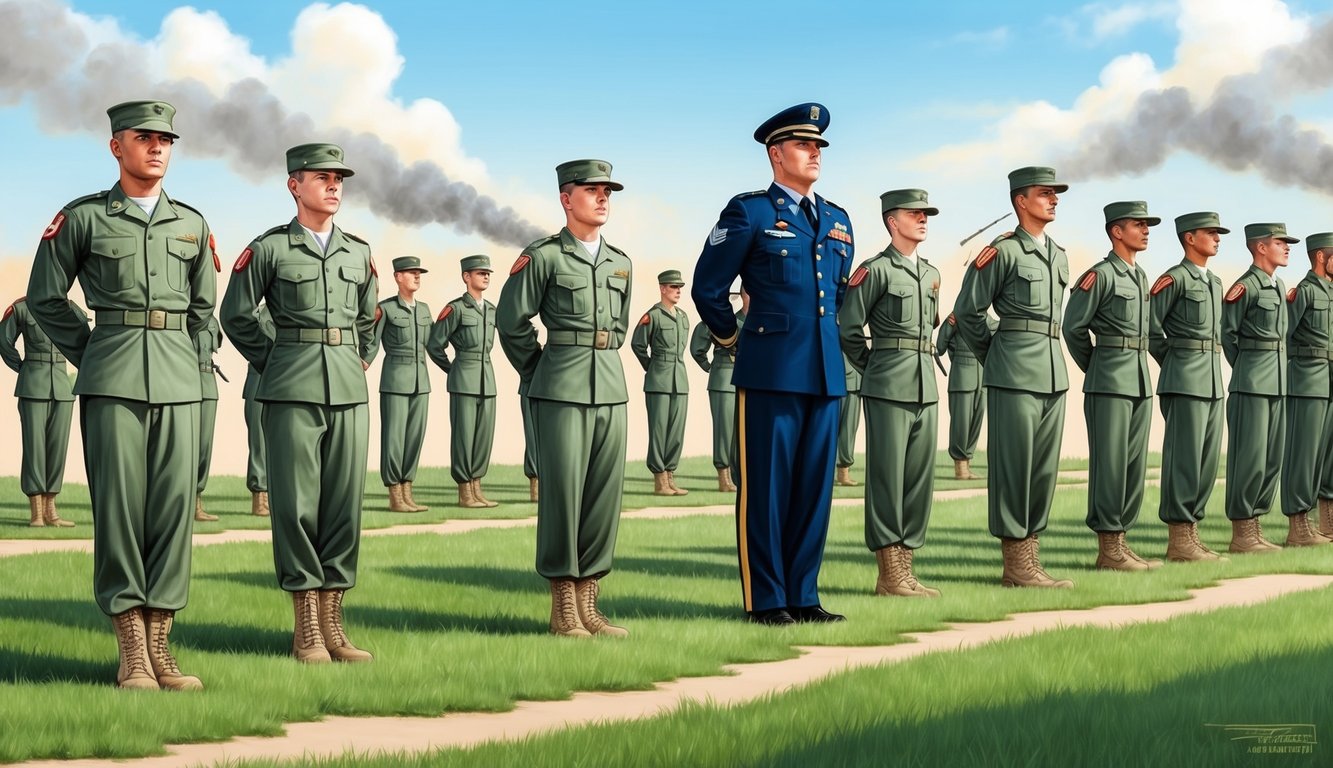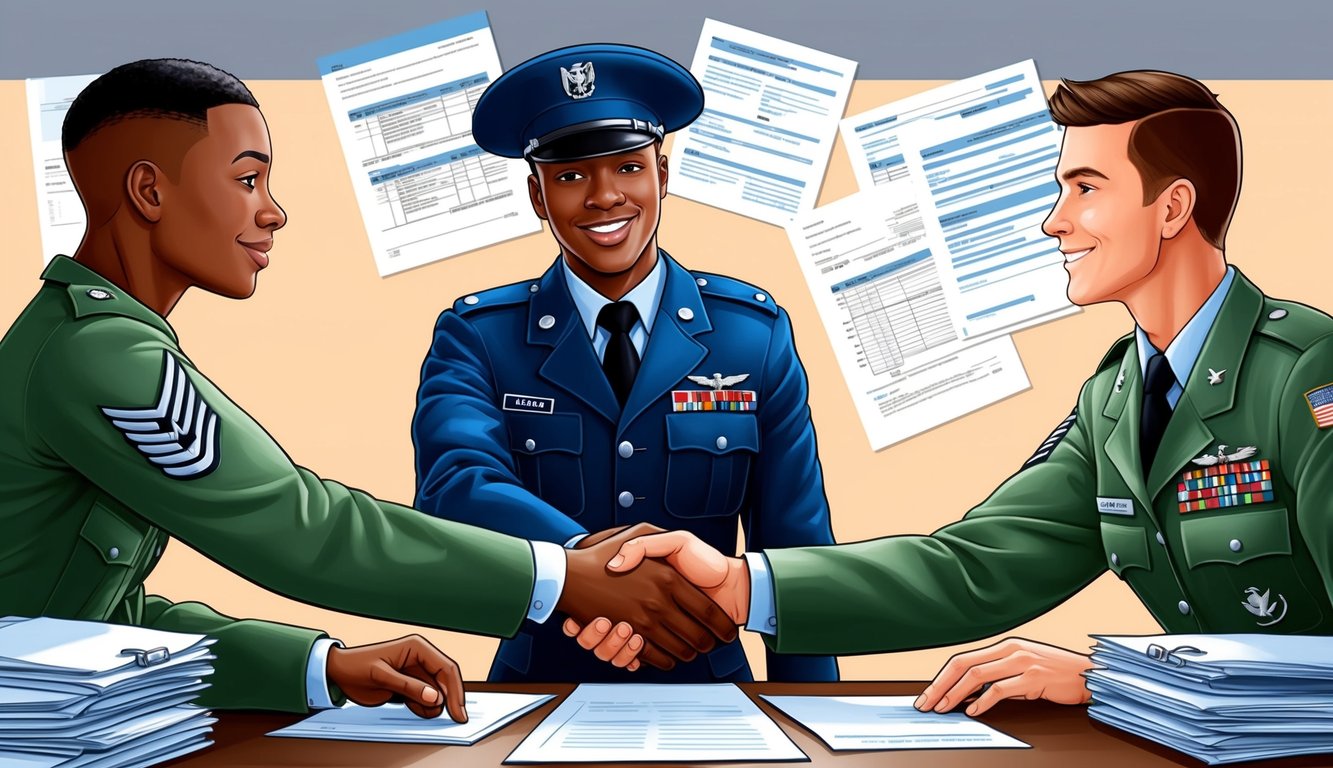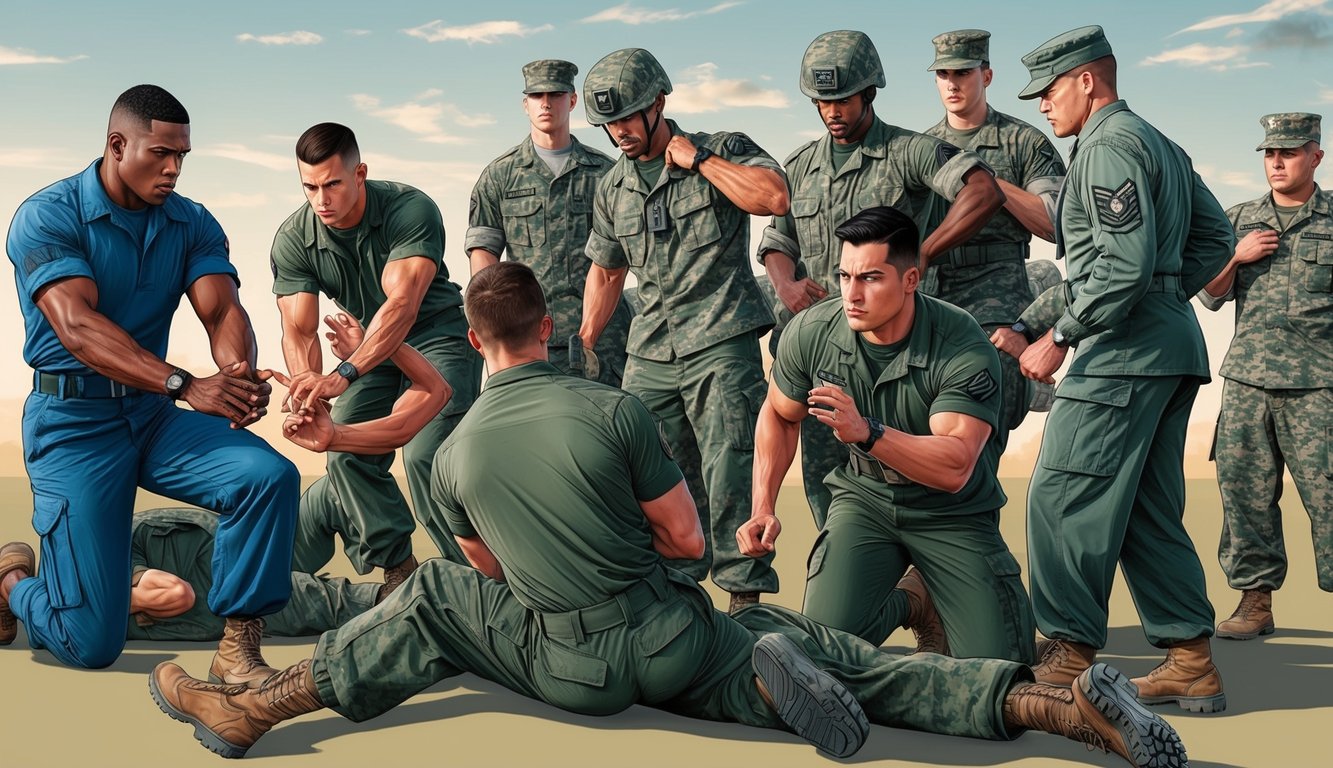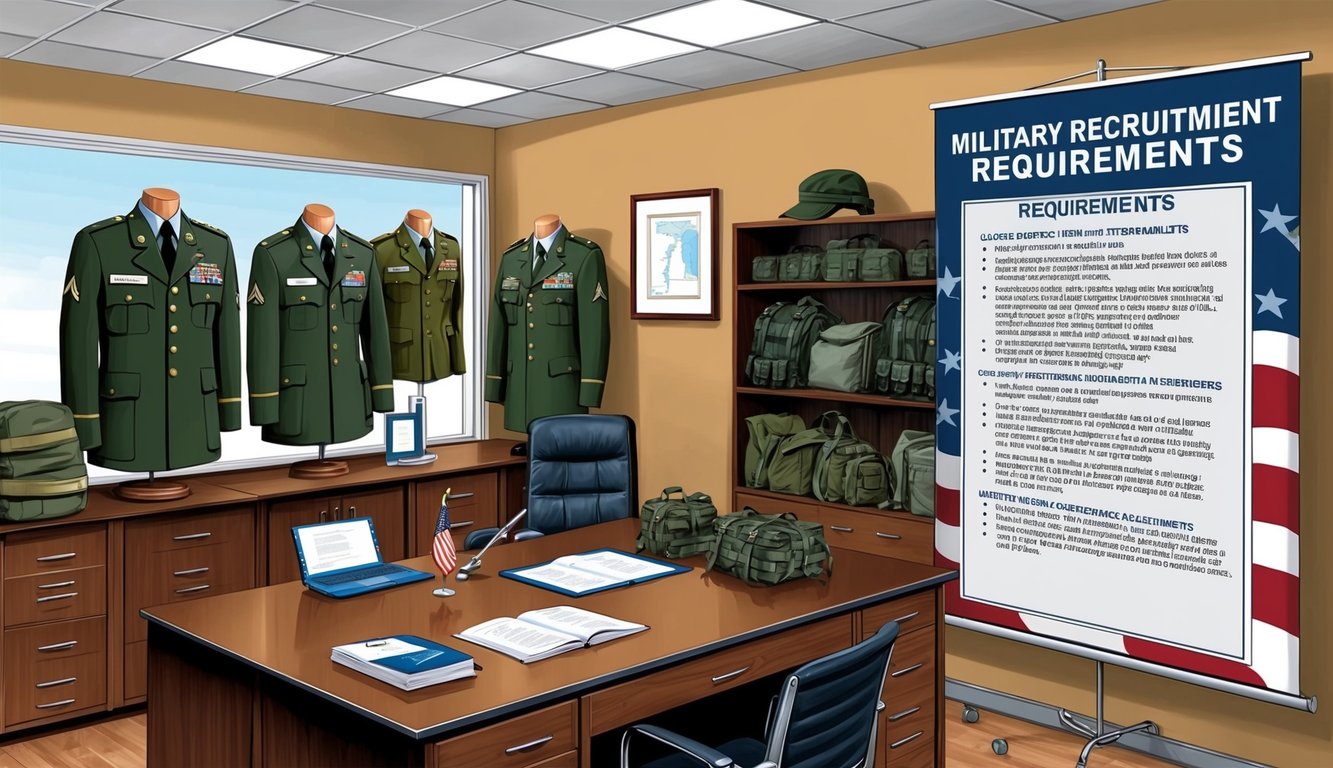Military recruitment is vital for maintaining the preparedness and capability of our armed forces.
If you’ve contemplated serving your country, familiarizing yourself with the required qualifications and the recruitment process can aid in making an informed choice.
The United States military has defined age limits, physical fitness benchmarks, and educational prerequisites for enlistment.
Joining the military can significantly alter your life, presenting distinctive avenues for personal development, career progression, and national service.
Each military branch offers various requirements and specialties, ensuring you can select a role that matches your abilities and passions.
The recruitment process is multi-faceted, including aptitude testing, medical evaluations, and interviews.
This structure seeks to guarantee that applicants are well-prepared for the challenges of military life and can make valuable contributions to their selected branch.
By grasping these criteria and adequately preparing, you can enhance your prospects of successfully joining the armed forces and commencing a fulfilling service career.
Key Takeaways
- Military enlistment entails meeting specific age, physical, and educational specifications
- Each branch presents distinctive opportunities and specialties for aspiring recruits
- Preparation and comprehension of the recruitment process can enhance your success likelihood
Understanding Military Recruitment
Military recruitment is a systematic approach to enrolling qualified candidates into the armed forces.
It entails various steps and requirements aimed at selecting individuals who can fulfill the rigor of military service.
Branch Overview
The U.S. military comprises five primary branches: Army, Navy, Air Force, Marine Corps, and Coast Guard.
Each branch carries its distinct missions and responsibilities:
- Army: Conducts land-based operations and ground combat
- Navy: Engages in maritime operations and sea security
- Air Force: Manages aerial and space operations
- Marine Corps: Specializes in expeditionary and amphibious missions
- Coast Guard: Focuses on maritime law enforcement and rescue operations
Each branch offers varied career paths and specialties.
You’ll encounter different cultures, traditions, and training styles across the military branches.
Roles of Recruiters
Military recruiters act as the initial contact during the enlistment journey.
Their primary responsibilities encompass:
- Providing insights about military careers and benefits
- Verifying your eligibility for service
- Assisting you throughout the application and enlistment process
- Responding to any inquiries regarding military life and expectations
Recruiters are trained to help align applicants with the most suitable military roles based on their skills, interests, and qualifications.
They can provide guidance on various job opportunities within their particular branch.
Pathways to Joining
When considering military service, several options are available:
- Active Duty: Full-time military service
- Reserve: Part-time service while retaining a civilian career
- National Guard: State-level part-time service with the potential for federal activation
Additional pathways include:
- Officer programs for college graduates
- ROTC programs for enrolled students
- Service academies for individuals pursuing military education
The commitment and benefits vary by path.
Selecting the right one depends on your educational background, career aspirations, and desired level of engagement.
The Enlistment Process
The military enlistment process typically involves the following stages:
- Initial contact with a recruiter
- Eligibility assessment
- Completion of the Armed Services Vocational Aptitude Battery (ASVAB)
- Medical examination at a Military Entrance Processing Station (MEPS)
- Job selection
- Taking the Oath of Enlistment
- Assignment to basic training
To qualify, you must fulfill age, citizenship, educational, and physical fitness requirements.
The duration of the process may vary from weeks to months, depending on your individual circumstances and chosen pathway.
The ASVAB evaluates your qualifications for diverse military occupations, and the MEPS conducts a thorough medical evaluation to confirm you meet the necessary physical standards.
Military Requirements and Qualifications
Enlisting in the military necessitates meeting specific criteria in several domains, including age, citizenship, education, physical fitness, and additional factors.
Basic Eligibility Criteria
To qualify for military service, you must be a U.S. citizen or a legal permanent resident with a valid Green Card.
The age range typically varies by branch, commonly between 17 and 41 years old.
A successful background check and a clean criminal record are essential.
Tattoos are permitted, yet there are restrictions.
The military has become more accommodating in recent times, but visible tattoos on the face, head, or neck are generally prohibited.
Educational Requirements
A high school diploma is the minimum educational requirement for most military roles.
In certain instances, a GED may be acceptable, contingent upon additional qualifications such as college credits.
For officer positions, a bachelor’s degree is required.
Some specialized roles may demand advanced degrees or specific technical training.
The Armed Services Vocational Aptitude Battery (ASVAB) test is required for all recruits, evaluating your academic and vocational skills to assist with placement.
Physical and Medical Standards
A comprehensive medical examination is necessary to ensure you’re fit for duty.
This entails vision and hearing tests and assessments for various health conditions.
Physical fitness is paramount, with each branch having its own fitness test such as the Army Combat Fitness Test (ACFT), typically testing elements such as push-ups, sit-ups, and running.
Height and weight standards differ by branch and role.
Specific body composition criteria must be met to guarantee effective performance in your duties.
Age, Citizenship, and Background
Age restrictions differ among branches; for instance, the Army recruits aged 17-35, while the Navy and Air Force extend to 39.
U.S. citizenship is mandatory for many roles, particularly those related to sensitive information.
However, permanent residents may enlist and could potentially acquire citizenship through their service.
Your background will undergo thorough scrutiny, encompassing criminal history, financial records, and substance use.
Minor infractions may be waived, but severe violations can disqualify you.
For non-citizens, residency requirements are typically enforced, necessitating a certain duration of U.S. residency prior to enlistment.
Training and Advancement

A career in the military offers extensive training and opportunities for advancement.
You’ll acquire valuable skills and experience while advancing through the ranks.
Initial Training Programs
Basic training serves as your introduction to military life, establishing foundational skills.
You’ll learn discipline, physical conditioning, and fundamental military knowledge.
The Army Combat Fitness Test (ACFT) gauges your strength, endurance, and agility.
Officer candidates partake in specialized programs like Officer Training School, honing leadership skills and preparing for command positions.
Each branch focuses on different training objectives; the Navy emphasizes seamanship, while the Air Force prioritizes aviation and technical skills.
Leadership Development
As you progress, leadership training becomes essential.
You’ll participate in courses tailored to your rank and responsibilities, enhancing your decision-making, communication, and management abilities.
Non-commissioned officers (NCOs) receive specialized leadership training for overseeing enlisted personnel.
Officer education persists throughout your career, equipping you for higher-command levels.
Many leadership courses utilize practical exercises and simulations, allowing you to practice solving problems in realistic scenarios.
Specialized Schools
The military provides numerous specialized training programs in fields such as intelligence, cybersecurity, and medical care.
Unique training opportunities exist within each branch; the Marine Corps offers advanced combat training while the Coast Guard provides maritime law enforcement courses.
Some specialties necessitate extensive training durations.
Language training, for instance, can last from several months to a year.
Career Progression
Your Military Occupational Specialty (MOS) defines your career trajectory.
As you accumulate experience, you’ll become eligible for promotions and expanded responsibilities.
Advancement depends on time served and performance reviews, with specific courses or qualifications often required for progression.
The military encourages ongoing education, facilitating opportunities for civilian education and professional development throughout your tenure.
Higher ranks usually entail broader skill sets, enabling transitions from technical roles to leadership or strategic positions as you elevate your career.
Service Commitment and Contracts

Joining the military involves signing legal agreements detailing your commitments and benefits.
These contracts specify the duration and nature of your service, as well as your roles and responsibilities.
Enlistment Contracts
Upon enlistment, you’ll sign a binding agreement with the military, outlining your initial service commitment—typically totaling eight years.
This includes about four years of active duty and the remainder in the reserves.
Your contract will encompass:
- Job assignment or training commitments
- Possible enlistment bonuses
- Education benefits
- Salary grade and promotion potentials
Carefully review your contract before signing.
Ensure everything is documented and inquire if anything is unclear.
Remember, verbal commitments not reflected in the contract hold no weight.
Active Duty Obligations
Active duty entails full-time military service, where your daily activities revolve around military duties, including the likelihood of deployment at any moment.
The duration of active service can vary by branch and designation:
- Army: 2-6 years
- Navy: 2-6 years
- Air Force: 4-6 years
- Marines: 4 years
- Coast Guard: 4 years
During this period, you’ll reside on a base or in military accommodation.
You’ll earn a regular salary, healthcare coverage, and other benefits.
Your time will not belong to you; adherence to orders and military regulations will be imperative.
Reserve and National Guard Service
The Reserve and National Guard offer part-time service alternatives.
You can maintain a civilian job while training one weekend a month and two weeks annually, typically committing to 3-6 years initially.
The key distinctions include:
- Reserves: Under federal management and may be deployed overseas
- National Guard: Operates under state authority (unless federalized), assisting in local emergencies
Both options deliver many benefits akin to those on active duty, allowing you to earn additional income, develop job skills, and access educational benefits.
Be ready for possible activation and deployment when necessary.
Leaving the Military
Terminating your service is not as straightforward as resigning from a civilian job; you’re bound by the terms of your contract.
Early discharge may be feasible but is not guaranteed.
Available options include:
- Completing your committed term of service
- Seeking early release (rare, under specific circumstances)
- Medical discharge
- Discharge due to hardship
Post-honorably discharged, you may have ongoing obligations in the Individual Ready Reserve, where you could be recalled to active duty during national crises.
Transitioning back to civilian life can pose challenges.
Utilize resources like the Transition Assistance Program to brace yourself for life after military service.
Life in the Armed Services
Military service features a distinctive lifestyle filled with both challenges and rewards.
You’ll experience a regulated environment, diverse opportunities, and a robust sense of camaraderie.
Daily Life and Culture
Your daily schedule in the military adheres to a structured routine.
Expect early mornings for physical training, along with your assigned duties and continued skills development.
Discipline and collaboration are the foundations of military culture.
You’ll learn to cooperate closely with individuals from all backgrounds.
Uniform standards are stringent, requiring specific attire for varying circumstances.
Grooming regulations are also enforced, including limits on hairstyles and tattoos.
Free time is available for leisure activities and socialization with fellow service members.
Many bases feature gyms, theaters, and other amenities.
Housing and Allowances
As a service member, you can choose from multiple housing options.
On-base accommodations are often available for both single and married personnel, while off-base housing is an option with a specified housing allowance.
If you reside off-base, you’ll receive a Basic Allowance for Housing (BAH), a tax-free payment designed to assist with rent and utilities.
Dormitory-style living often applies to junior enlisted personnel, with improvement in housing quality typically occurring as you advance in rank.
Assignments abroad may involve government-provided housing or additional allowances for local rentals.
Personal Benefits
The military provides a competitive benefits package.
Your compensation comprises base salary, special allowances, and bonuses.
Throughout your service, health insurance covers you and your dependents, granting access to both military and civilian healthcare facilities.
You’ll accrue 30 days of paid vacation each year, known as leave.
Tuition assistance programs enable you to pursue advanced education while active.
The GI Bill offers extensive educational benefits post-service.
Retirement benefits encompass a pension scheme alongside the Thrift Savings Plan, which serves as the government equivalent of a 401(k).
Family Support
The military acknowledges the importance of family in service members’ lives.
Support services encompass childcare facilities, youth programs, and family readiness initiatives.
Spouse employment assistance programs are available to help partners find jobs, especially during moves.
Military families can access on-base educational programs or receive assistance with enrolling their children in local schools.
Various support systems are in place during deployments to aid families in coping with separation, including counseling and communication tools.
Recreational initiatives offer discounted travel and leisure activities for service members and their families.
Resources and Help
The military offers a wealth of resources to aid service members throughout their careers and beyond.
Educational benefits, career support, and comprehensive services are readily available to ensure your success.
Education Opportunities
While serving, you can capitalize on tuition assistance programs that cover up to 100% of tuition costs for qualified courses.
This enables you to earn degrees or certifications with minimal financial impact.
Post-service, the GI Bill provides significant educational benefits, covering tuition, housing, and supplies for approved programs.
You can apply it toward college, vocational schools, or job training.
Many military installations house education centers offering academic counseling, testing services, and computer facilities.
Here you’ll find resources to help you achieve your educational objectives.
Career Counseling
Military career advisors assist with future planning, providing guidance on opportunities within the service and civilian sectors.
They offer insight into career trajectories, training programs, and promotion criteria.
Transition assistance programs are available to prepare you for civilian life, supplying resume workshops, interview coaching, and job search strategies to help you translate military experience into civilian language.
Job placement services connect you with employers who actively seek veterans for their skills and leadership qualities.
Benefits and Support Programs
Military benefits extend beyond active duty.
TRICARE provides healthcare coverage for you and your family, which includes medical, dental, and vision care at both military and civilian facilities.
You may receive housing allowances to help cover expenses, qualifying for on-base living or receiving funds for off-base housing.
The VA offers advantageous terms for home loans.
Family support initiatives include childcare, counseling, and assistance with relocations, facilitating a balance between military commitments and family life.
Financial counseling can equip you with budgeting and financial management strategies, empowering you to save, invest, and plan for retirement.
Veterans Affairs
The Department of Veterans Affairs (VA) continues to offer support following your service.
VA hospitals and clinics provide extensive healthcare services, treating both service-related conditions and general medical concerns.
Disability compensation is available for service-connected injuries or ailments, with the VA evaluating your conditions to offer monthly payments based on severity.
The VA also offers mental health services, including counseling and PTSD treatment, accessible at VA facilities or through community providers.
Programs for vocational rehabilitation assist disabled veterans in securing suitable employment, offering job training, resume guidance, and workplace accommodations.
Testing and Preparation Strategies

The military utilizes various assessments to evaluate potential recruits, measuring cognitive capabilities, physical fitness, and leadership potential.
Effective preparation is vital for success in these evaluations.
Preparing for the ASVAB
The Armed Services Vocational Aptitude Battery (ASVAB) is a key component for military enlistment, assessing your knowledge across areas such as arithmetic reasoning, verbal comprehension, and mechanical understanding.
To prepare efficiently, begin studying at least two months in advance of your test date, emphasizing your weaker subjects first.
Engage in practice tests to become familiar with the format and timing.
Utilize ASVAB study guides or online platforms, which often provide practice questions and test-taking techniques.
Particular attention should be given to math and verbal sections, as they heavily influence your overall score.
Physical Fitness Preparation
Military service demands a high level of physical fitness.
Though each branch has unique fitness standards, core requirements usually include strength, endurance, and agility.
Begin your workout routine well in advance of your intended enlistment.
Focus on cardiovascular training like running, swimming, or cycling, and integrate strength exercises to enhance muscle growth and overall fitness.
Familiarize yourself with specific military fitness tests, which may include:
- Push-ups
- Sit-ups or planks
- Pull-ups (for certain branches)
- Timed running
Gradually increase the intensity and duration of your regimen, aiming to exceed the minimum standards outlined by your chosen branch.
Proper nutrition is essential as well; maintain a well-rounded diet with ample protein, complex carbohydrates, and healthy fats.
Applying for Officer Programs
Officer programs generally necessitate a college degree.
If this path intrigues you, strive to maintain a high GPA and take part in leadership opportunities.
Research the distinct requirements for your desired branch and program.
Common options include:
- Reserve Officers’ Training Corps (ROTC)
- Officer Candidate School (OCS)
- Direct Commission
Prepare for additional assessments, such as the Officer Aptitude Rating (OAR) for the Navy, aimed at measuring leadership capacity and problem-solving skills.
Enhance your communication skills through public speaking courses or writing workshops, and leverage leadership experiences from clubs or sports to augment your application.
Study Resources and Guides
An array of resources is available to aid your preparation for military assessments and criteria.
Your local recruitment office can furnish official study materials and practice tools.
Many online platforms provide interactive study aids and practice exams, such as Military.com, which features free ASVAB practice tests and study guides.
Consider joining study groups or enlisting a tutor; peer support can be instrumental in maintaining motivation and accountability during your preparations.
For physical readiness, numerous gyms offer boot camps akin to military training, assisting in building the strength and endurance necessary for basic training.
Employ a variety of study methods to keep your preparation dynamic and effective.
Frequently Asked Questions
Enlisting in the military requires understanding specific criteria and essential requirements.
Below are responses to some common inquiries regarding military enlistment and service eligibility.
What are the age limits for enlistment in the military?
Age limits are branch-specific.
The Army accepts recruits aged 17-35, whereas the Navy and Coast Guard allow enlistment up to 41 years old.
The Marine Corps has a lower cutoff at 28, while the Space Force admits applicants up to 42.
Are there different requirements for joining the military as a female?
Physical fitness benchmarks differ by gender, though core eligibility criteria remain uniform across applicants.
Women can serve in all military positions, including combat roles once restricted to men.
What are the basic eligibility criteria for enlisting in the U.S. Army?
Eligibility requires being a U.S. citizen or a permanent resident alien.
A high school diploma or equivalent is mandatory.
Applicants must pass the ASVAB test and meet physical fitness standards, in addition to maintaining a clean criminal record and good moral character.
Can non-U.S. citizens enlist in the U.S. Army, and what are the prerequisites?
Yes, permanent resident aliens can enlist, provided they hold a valid Green Card and have resided in the U.S. for at least one year.
Proficiency in speaking, reading, and writing English is also necessary.
Certain roles may be reserved for U.S. citizens only.
What medical or physical conditions can disqualify someone from military service?
Disqualifying conditions may include severe heart issues, mental health disorders, and some chronic illnesses.
Poor vision, hearing problems, and serious allergies could also hinder eligibility.
Each case is evaluated individually; some conditions may be waived.
How many years of commitment are typically required when enlisting in the military?
The average initial enlistment commitment is usually four years of active duty.
Specialized roles may require longer engagements.
Following active duty, a typical additional commitment of four years is served in the reserves.
Shorter contracts might be available for particular positions.

